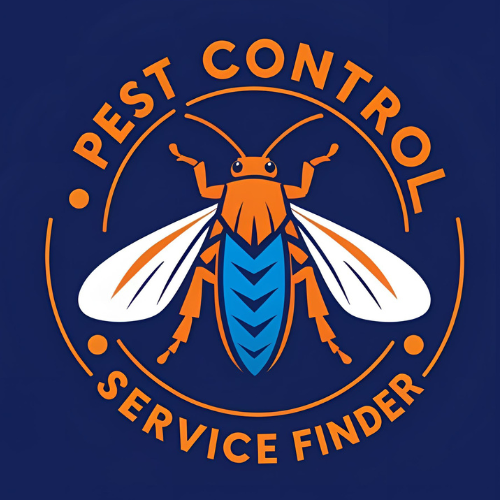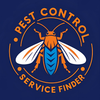A Guide to Using Bug Bombs for Gnats
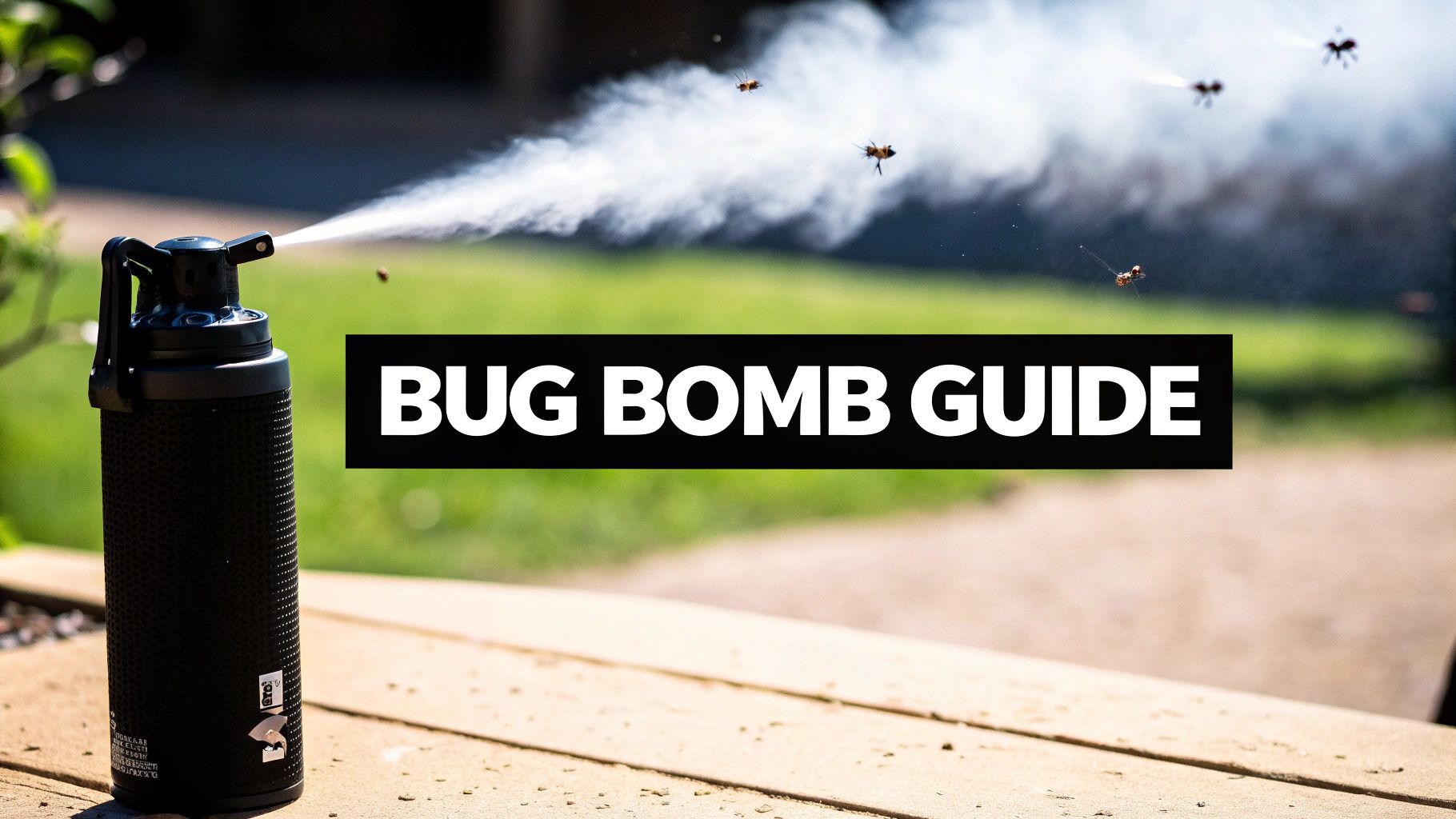
When you're dealing with a frustrating gnat problem and need immediate help, call +1 855 224 3071 for professional advice. While grabbing a bug bomb might feel like a quick win, it often only takes out the adult gnats you can see, leaving the eggs and larvae safe in your drains or potting soil. This almost guarantees the infestation will come roaring back.
Understanding Bug Bombs and Their Role in Gnat Control
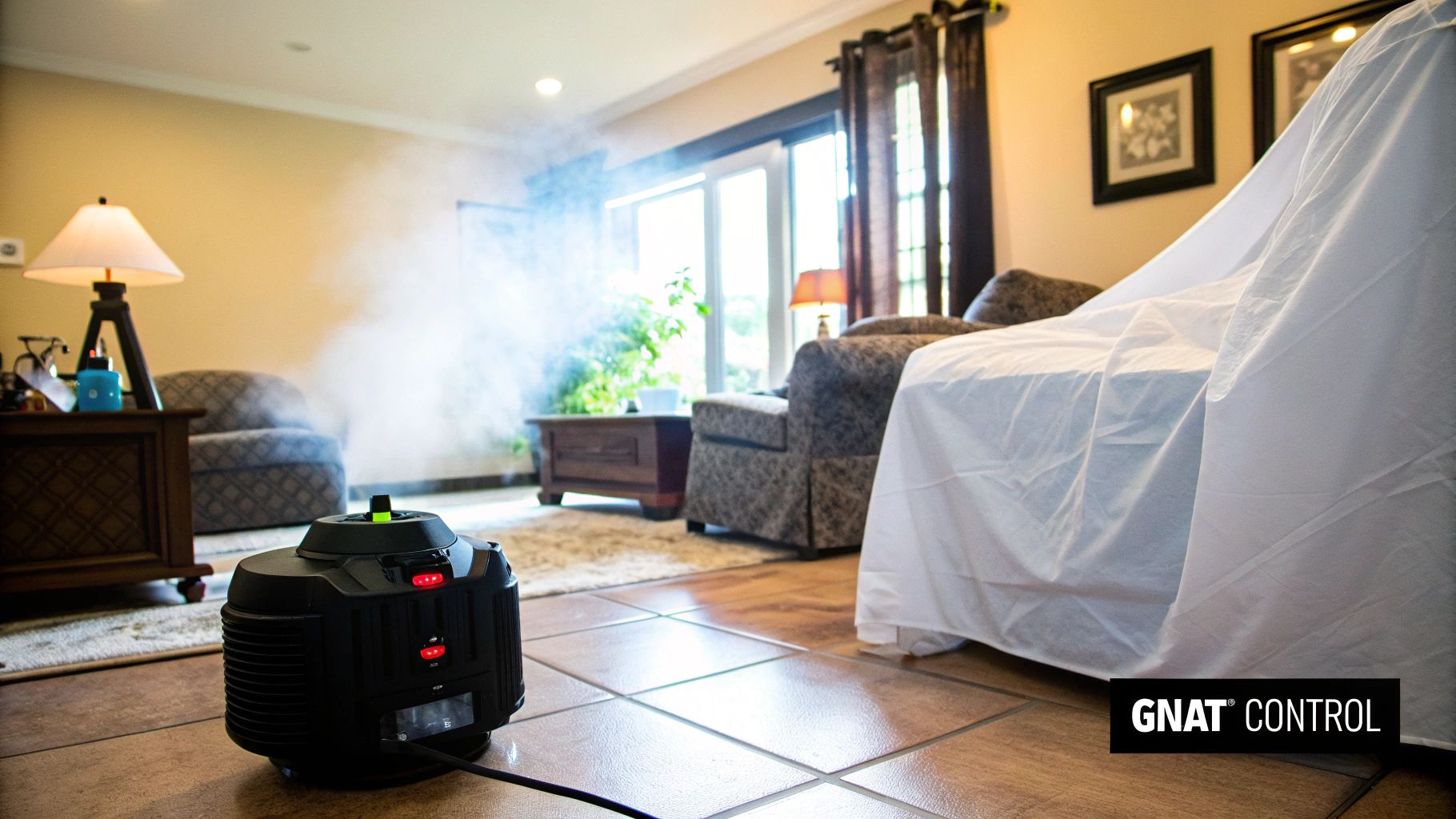
When your home is buzzing with a cloud of tiny gnats, the thought of setting off a "bug bomb" is pretty tempting. Officially known as a total release fogger, this is the classic set-it-and-forget-it solution. You just press the button, leave the room, and let a cloud of insecticide do the work.
The biggest draw is convenience. Instead of chasing gnats with a spray bottle, a fogger promises to treat the entire room in one go, hitting spots you might miss. But that broad-stroke approach is also its fatal flaw, especially with a pest as stubborn as the gnat. If you're stuck in a never-ending battle, it's time for expert help; call +1 855 224 3071 to connect with a specialist who can actually solve the problem.
How Foggers Actually Work
Think of a bug bomb like a mini fire extinguisher, but instead of foam, it's packed with insecticide. Once you trigger it, the canister unleashes its entire contents as an aerosolized cloud. This fog lingers in the air before eventually settling on every single exposed surface in the room.
The active ingredients are usually neurotoxins designed to kill insects on contact.
Bug bombs, or insecticide foggers, became a go-to for homeowners in the late 20th century because they could spread insecticide everywhere indoors. A typical fogger can treat an area between 600 to 800 square feet, but its success hinges entirely on using it exactly as the manufacturer instructs. You can find more insights on gnat foggers on ridmycritters.com.
The Limits of Bug Bombs for Gnats
So, here's the catch. While the fog will definitely kill adult gnats zipping around during the treatment, it does absolutely nothing about the source of the infestation. Gnats don't just hang out in the open; they breed in very specific, hidden places.
- Fungus Gnats: These guys lay their eggs in the damp soil of your houseplants. The fog might coat the top of the soil, but it can't seep down deep enough to kill the eggs or larvae living there.
- Drain Flies (a type of gnat): They make their home in the gross, organic sludge lining your sink drains and garbage disposal. An aerosol mist just isn't going to penetrate that gunk.
- Fruit Flies: Another common gnat, these lay eggs in overripe fruit or the bottom of your trash can—places where the insecticide simply won't be effective.
Because bug bombs only knock out the adults, you're just resetting the clock. A fresh generation of gnats will hatch from their protected breeding grounds within a few days, and you're right back where you started. For a real solution that breaks the entire lifecycle, call +1 855 224 3071.
To put it simply, using a bug bomb for gnats is like mowing over weeds without pulling out the roots. It looks better for a little while, but the problem hasn't gone anywhere.
Bug Bomb Effectiveness for Gnats At a Glance
Here’s a quick breakdown of what you can realistically expect when using a bug bomb to tackle a gnat problem.
| Aspect | Potential Advantage (Pros) | Significant Disadvantage (Cons) |
|---|---|---|
| Adult Gnat Elimination | Can kill adult gnats that are flying in the open during treatment. | Does not affect any gnats that are not in the room at the time. |
| Breeding Site Impact | None. Offers zero impact on the source of the problem. | Fails to penetrate soil, drains, or garbage where eggs and larvae live. |
| Long-Term Control | Provides immediate, but very temporary, visual reduction of gnats. | Gnat population will return quickly as new larvae mature. |
| Ease of Use | Simple to activate and requires minimal effort from the user. | Requires significant prep to cover items and vacate the premises for hours. |
| Safety and Residue | N/A | Leaves a chemical residue on all exposed surfaces in the room. |
Ultimately, the table shows that while a bug bomb offers a moment of satisfaction by killing visible gnats, it's a fundamentally flawed strategy for achieving long-term control. The cons far outweigh the pros for this particular pest.
The Hidden Dangers of Gnat Foggers
A gnat fogger might seem like the perfect set-it-and-forget-it weapon against a swarm of annoying gnats. But the convenience of that little can comes with some serious downsides that every homeowner needs to know about. Behind the promise of an easy fix are real health hazards and a fundamental flaw that makes them ineffective.
For a safer, more thorough treatment that actually works, your best bet is to Call +1 855 224 3071.
The biggest problem with any bug bomb is the chemical mess it leaves behind. When that aerosol mist settles, it coats everything in the room—your countertops, the sofa, the floors, and even your kids' toys. That residue is packed with pesticides, and it can be harmful if you don't handle the cleanup perfectly.
Those chemicals are designed to kill insects, and they don't just magically become safe once the fog clears. Getting rid of that residue is a huge job, turning your "easy fix" into a complicated and risky cleanup project.
Chemical Exposure and Health Risks
The safety warnings on a gnat fogger aren't just suggestions—they are there for a very good reason. You, your family, and all your pets have to completely vacate the house for several hours. This is a non-negotiable step to avoid breathing in a cloud of insecticide.
When you return, you have to air everything out. That means opening every single window and running fans for at least 30 minutes just to start clearing the airborne chemicals. But even then, the sticky residue stays on surfaces, creating a risk of exposure through skin contact or accidental ingestion.
This is a huge concern in homes with small children or pets, who are always on the floor and tend to put things in their mouths. If you're worried about chemical exposure, professional pest control offers targeted treatments that keep your family safe. You can discuss better options when you Call +1 855 224 3071.
A recent CDC analysis brought these dangers to light, reporting that a huge number of poison control calls come from people who either didn't leave the house during fogging or came back way too soon. In fact, the CDC tracked over 1,500 pesticide exposure calls in the U.S. linked to foggers in 2022 alone. This shows just how easy it is to make a dangerous mistake. You can learn more about the dangers and ineffectiveness of bug bombs from University of California research.
The Ineffectiveness of Surface-Level Treatment
Safety issues aside, the biggest reason to skip the bug bomb is simple: it doesn't solve the problem. Foggers are designed to kill adult gnats flying around in the open. The mist settles on top of surfaces, but it can't get into the hidden nooks and crannies where gnats actually breed.
This means the source of your gnat infestation is left completely untouched.
A critical report from the University of California Agriculture and Natural Resources confirms this, stating that foggers only affect insects directly exposed to the pesticide fog. This leaves pests hidden in cracks, under furniture, or in other protected spots completely unaffected.
This failure all but guarantees that a fresh wave of gnats will appear in just a few days. You get trapped in a frustrating cycle of repeat treatments, which just means more chemical exposure in your home.
Here’s where gnats are hiding that a fogger can’t possibly reach:
- Houseplant Soil: Fungus gnat larvae are having a field day in the damp soil of your potted plants, and a fogger’s mist won’t even touch them.
- Sink Drains: Drain gnats lay their eggs in the gross, organic gunk lining your pipes—a place no aerosol cloud can penetrate.
- Garbage Disposals: Just like drains, the inside of your garbage disposal is a five-star hotel for breeding gnats.
Because gnat foggers only kill the adults you can see, the infestation is bound to come roaring back. For a real solution that targets the problem at its source—the eggs and larvae—you need a professional strategy. Get the expert help you need by calling +1 855 224 3071 today.
A Step-by-Step Guide to Using a Gnat Bomb Safely
So, you've weighed the pros and cons and decided a bug bomb is the route you want to take. If that’s the case, using it correctly isn't just a suggestion—it’s absolutely critical for your safety. Following the instructions to the letter is the only way to minimize the risks.
But let's be honest, if the prep work and the warnings feel a bit much, remember that a guaranteed, professional treatment is just a phone call away. For expert help, you can Call +1 855 224 3071 anytime.
Think of this process in four distinct stages: preparation, placement, activation, and re-entry. Skipping even one small step can lead to a failed treatment or, far worse, expose you to dangerous chemicals. It's like building IKEA furniture—if you leave out one screw, the whole thing could fall apart.
Prepare the Area Thoroughly
Before you even think about pushing that button, you have to prep the room. This is the most demanding part of the job, but it's also the most important for protecting your health, your family, and your belongings from pesticide residue.
Your number one priority is protecting anything that might come into contact with food or mouths.
- Remove or Cover All Food-Related Items: Get all food, dishes, glasses, silverware, and small kitchen appliances completely out of the room. If removal isn't an option, seal them in cabinets or cover them entirely with thick plastic sheets, taping down all the edges.
- Protect Surfaces: Cover your countertops, tables, and any other surface where you prepare food. Use plastic or old sheets—that chemical mist settles on everything.
- Unplug Electronics and Extinguish Flames: The propellants in these foggers are often extremely flammable. To prevent a fire hazard, unplug every single electrical appliance. That means refrigerators, TVs, computers, and lamps. You also must extinguish any pilot lights on your stove, water heater, or furnace.
This graphic breaks down the essential prep steps for using a bug bomb safely.
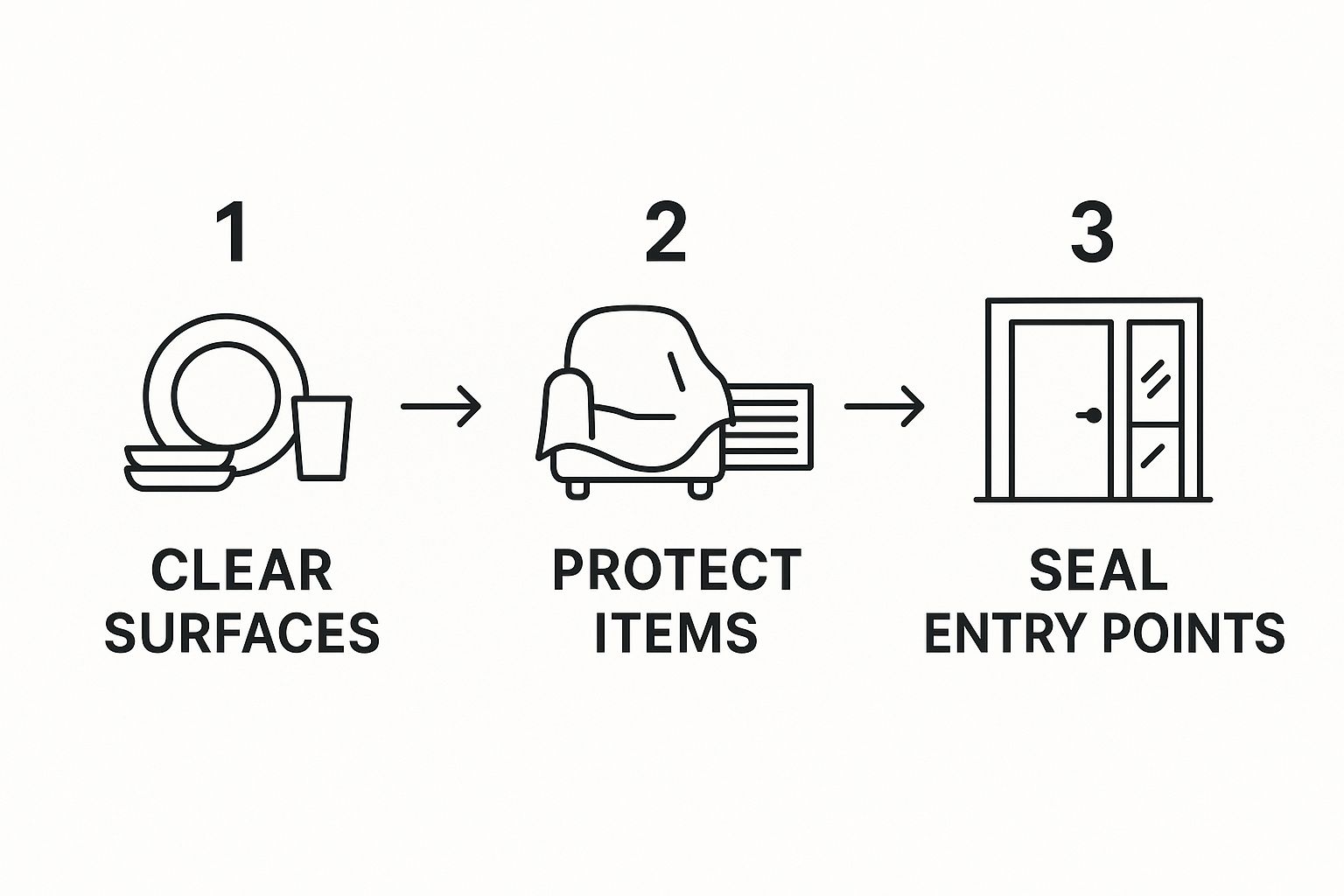
As you can see, the process is all about clearing surfaces, protecting what stays, and sealing the room to keep the insecticide contained.
Clear All Living Things and Place the Bomb
Next, you have to get every living thing out of the area. This means all people, all pets, and yes, even your houseplants. The chemicals in a fogger are toxic to all living things, not just the gnats you're targeting.
Remove all pets, and that includes fish in tanks. The insecticide can easily poison the water. You'll also want to move your houseplants outside or to another room, as the chemicals can kill them.
For the bug bomb to have any chance of working on gnats, placement is key.
The whole idea is to let the aerosol mist spread as freely as possible. Where you put the can makes a huge difference in whether the fog reaches open areas or just gets blocked by furniture.
Set the fogger in the middle of the room, preferably on a small table or chair to give it some height. To avoid stains, place a thick layer of newspaper or a plastic sheet under the can. Also, make sure nothing is directly above it to block the spray. If you have any hesitation about doing this safely, Call +1 855 224 3071 for professional advice.
Activate, Vacate, and Ventilate
With all the prep work done, it's go-time. Close all the windows and any interior doors leading into the room you're treating.
Shake the can vigorously, put it in place, and then press the trigger to lock it. The can will start spraying immediately. Leave the room right away. Don't hang around for even a second. Close the door firmly behind you.
Now, you need to stay out. Check the product label for the required time, which is usually between two to four hours. I recommend setting a timer on your phone so you don't accidentally go back in too early.
Once the time is up, the final and most important step is ventilation.
- Open all windows and doors in the treated room to get fresh air flowing.
- Turn on any fans you have to speed up the airing-out process.
- Let the room ventilate for at least 30 to 60 minutes before letting anyone—people or pets—back inside.
Finally, you’ll need to put on some gloves and wipe down every exposed surface with soap and water to clean off any chemical residue before you use the room again. Even after all that, there's no guarantee it will solve your gnat problem. For a complete fix without the risk and hassle, Call +1 855 224 3071.
If you want a gnat control strategy that gets the job done right, forget the foggers and talk to an expert. Call +1 855 224 3071 to connect with a pest control pro who can wipe out gnats where they start.
More Effective Alternatives to Bug Bombs
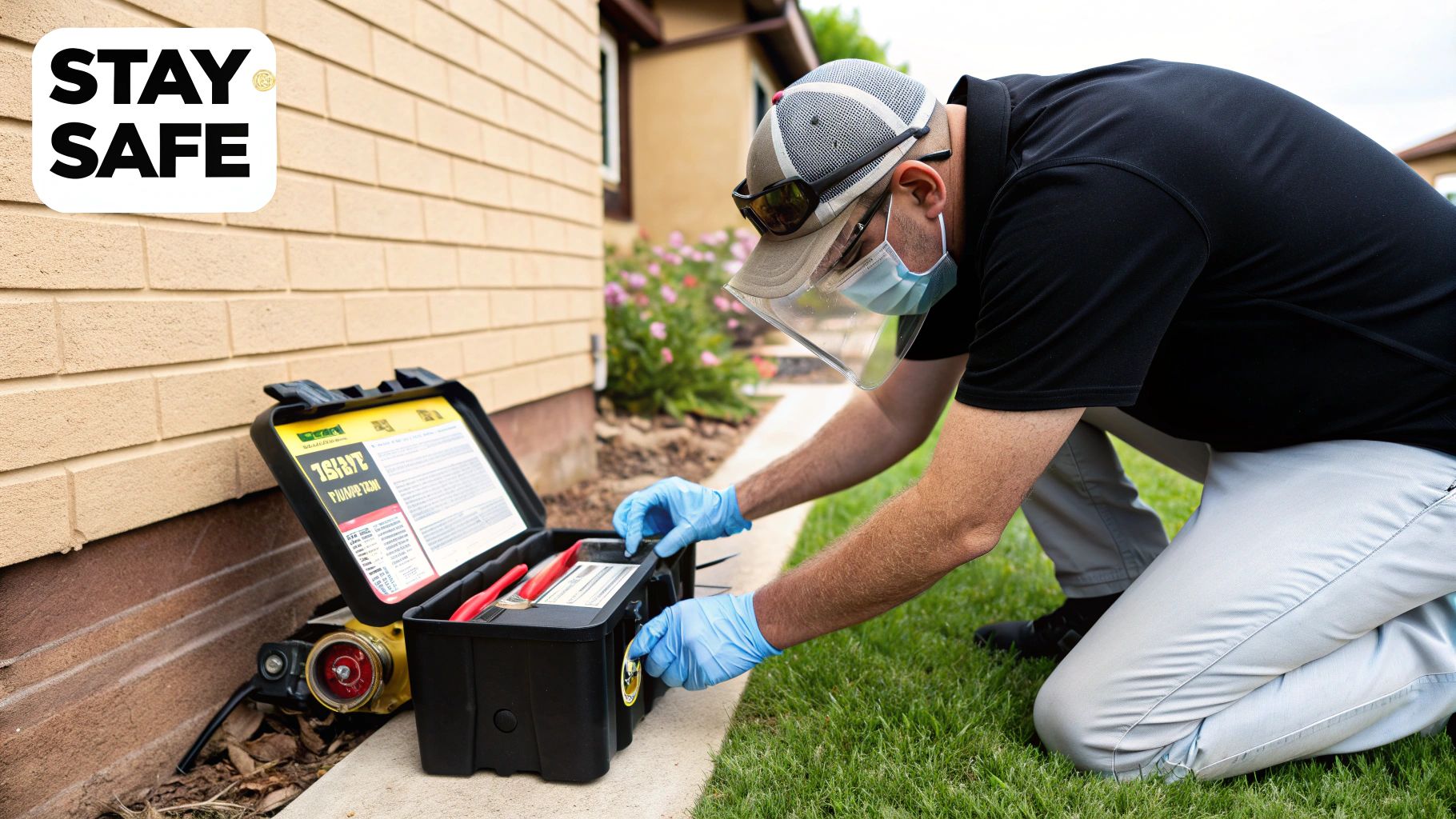
When you’re swatting at a cloud of gnats, your first thought is probably to grab the biggest weapon you can find. Bug bombs definitely look the part, but they're almost always the wrong tool for this fight. Getting rid of gnats for good isn't about waging all-out chemical warfare in your home—it’s about using smart, targeted tactics that break their life cycle.
The pros call this Integrated Pest Management (IPM), and it’s a strategy focused on getting rid of the root cause. Instead of a one-and-done chemical blast, IPM hits the problem from multiple angles by eliminating breeding sites and trapping the stragglers. This gives you lasting results without the unnecessary risks. If that sounds like a lot to handle, a quick call to +1 855 224 3071 gets a professional to build that plan for you.
Eliminate the Breeding Grounds
The most critical step—bar none—is to destroy their nurseries. Gnats don't just magically appear. They need specific conditions to lay their eggs: somewhere moist with plenty of organic gunk to eat. Take that away, and you stop the next generation before it even starts.
Think of it this way: a bug bomb only kills the adult gnats you see flying around. That’s like swatting a few bees without ever touching the hive. To actually solve the problem, you have to go after the hive itself. For gnats, that "hive" is often hiding in plain sight.
Here are the most common gnat hotspots in any home:
- Overwatered Houseplants: That damp soil in your favorite potted plant is basically a five-star resort for fungus gnats. Let the top two inches of soil dry out completely before you water again.
- Dirty Drains: See that slimy, gross buildup inside your kitchen and bathroom drains? That's a perfect breeding ground for drain gnats.
- Garbage Disposals and Trash Cans: Leftover food scraps plus a little moisture is an open invitation for both drain gnats and their cousins, the fruit flies.
Deploy Smarter Trapping Methods
Once you've shut down the breeding sites, it's time to deal with the adult gnats still buzzing around. Ditch the fogger and set up traps that work 24/7 to catch them. These methods are way safer, more targeted, and surprisingly effective.
DIY Apple Cider Vinegar Traps
This is a classic for a reason—it just works. Gnats can't resist the smell of fermented vinegar.
- Pour an inch or so of apple cider vinegar into a small jar or bowl.
- Add a couple of drops of dish soap. This is the secret ingredient; it breaks the surface tension so the gnats sink and drown.
- Cover the top with plastic wrap and poke a few small holes in it. They’ll crawl in for a drink but won't be able to get back out.
Gnats reproduce like crazy. A single female can lay up to 300 eggs in just a week, which is why a small problem can explode overnight. These homemade vinegar traps are a fantastic, non-chemical weapon against them. In fact, some studies show traps like this can slash indoor gnat populations by over 60% in a single week. Not bad for a little vinegar and soap. Find out more about getting rid of gnats on aaipest.com.
By combining source control with continuous trapping, you create a hostile environment where gnats simply cannot survive or reproduce. This integrated strategy delivers far better, safer, and more permanent results than any bug bomb.
Commercial Trapping Solutions
If you're not the DIY type, there are some great off-the-shelf options that work just as well:
- Sticky Traps: These are basically bright yellow flypaper cards. Gnats are drawn to the color, land on the trap, and get stuck for good. They're perfect for sticking in houseplants or placing near sinks.
- Electric Gnat Zappers: These little devices use a UV light to attract gnats and other flying pests, then zap them on contact. They work great for clearing the air in a specific area, like your kitchen.
This one-two punch of eliminating breeding grounds and using traps is the core of modern pest control. It’s a smarter and more sustainable way to take back your home from gnats. For a professionally managed IPM plan, Call +1 855 224 3071.
When to Call a Pest Control Professional
For a gnat problem that just won't quit, your best bet is to Call +1 855 224 3071 and schedule a professional consultation.
Sure, DIY methods like vinegar traps and clearing out drains can definitely help. But sometimes, they're just not enough to get your home back from a stubborn cloud of gnats. Knowing when you've hit that wall is the first step to finding a solution that actually works for good.
It's an exhausting cycle, isn't it? You set out traps, scrub the drains, and maybe even set off a bug bomb, only for the gnats to pop back up a week later. If that sounds like your life right now, it’s a huge sign the infestation is too deep for surface-level fixes.
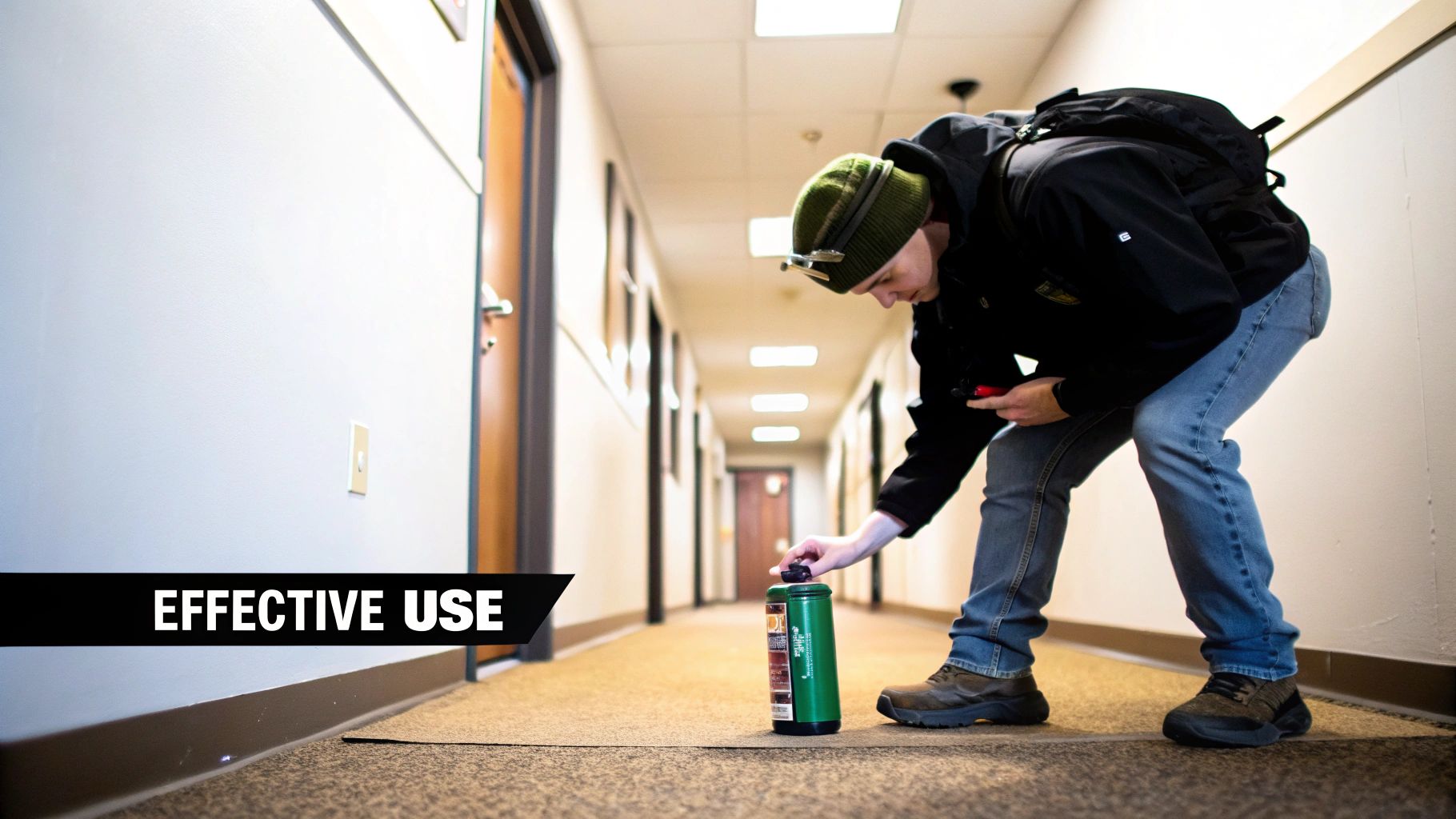
Signs It Is Time for Expert Help
Knowing when to throw in the towel on DIY and call in a pro can save you a ton of time, money, and frustration. If you’re dealing with any of these situations, it’s time to stop the experiments and get an expert on the line.
- Recurring Infestations: You get rid of them for a little while, but they always return. This is a classic sign you haven't found their breeding source, and a professional is trained to hunt it down.
- Widespread Problem: The gnats aren't just hovering over the kitchen sink anymore. Seeing them in the bathroom, living room, and bedrooms means the problem has spread and is bigger than you think.
- Unable to Find the Source: You've checked the plants, cleaned every drain, and the trash is always out. If the gnats are still there, a pro can spot hidden moisture problems or breeding sites you'd never think to look for.
If you’re facing a relentless swarm, don’t let it get any worse. Call +1 855 224 3071 for immediate help.
The Advantages of Professional Gnat Control
Hiring a licensed pest control expert brings a level of firepower that DIY methods just can't touch. They have the knowledge, tools, and treatments that are way more effective than anything you can buy at the store. The difference in results is night and day.
One of the biggest advantages is simply knowing what you're up against. Not all gnats are created equal. A pro can tell in a heartbeat if you have fungus gnats, drain flies, or fruit flies—and that’s critical, because each one needs a different game plan. Trying to use a fungus gnat solution on drain flies is a recipe for failure.
Professionals develop a custom plan that attacks the entire gnat lifecycle—from egg to adult—to eradicate the problem for good. This comprehensive approach is the only way to break the cycle of infestation permanently.
Plus, technicians use commercial-grade products that are not only more potent but are often safer when applied correctly. Instead of fogging your whole house with chemicals from a bug bomb, they apply precise treatments directly where the gnats are breeding. This targeted strike is more effective and keeps your family's exposure to pesticides at a minimum. You can find a network of vetted local specialists by checking out a Pest Control Service Finder.
A pro doesn’t just get rid of the current swarm; they help you put a stop to future ones. They’ll pinpoint and help you fix the root causes—like hidden leaks or poor ventilation—that made your home a gnat paradise in the first place.
Don't let gnats run your home. For a fast, effective, and guaranteed fix, end the frustration now and Call +1 855 224 3071.
Answering Your Top Questions About Gnat Bug Bombs
So, you're still on the fence about using a bug bomb for gnats? You've probably got a few questions still buzzing around. For straight answers and solutions that actually get the job done, Call +1 855 224 3071 to talk with a pest control expert. Let's tackle the most common concerns homeowners have so you can make a smart, safe decision.
DIY pest control can feel like a maze, especially with a frustrating pest like gnats. It's vital to know what you're getting into with products like bug bombs—their limits and the safety rules you absolutely can't bend.
How Long Should I Stay Out of My House After Using a Gnat Bomb?
This is non-negotiable: you have to follow the product's instructions to the letter. Most manufacturers will tell you to stay completely out of the treated area for at least two to four hours, though some foggers require an even longer wait time.
Read the label on your specific bug bomb for the exact time. This isn't a suggestion. Once that time is up, you're not done yet. You have to completely air out your home before anyone—people or pets—goes back inside.
Here’s the right way to do it:
- Open every single window and door in the rooms you treated.
- Get some fans going to really circulate the air and push out any leftover fumes.
- Let the space air out for a solid 30 to 60 minutes after the initial waiting period.
Going back in too early is a bad idea. It can expose your family to lingering insecticide fumes, leading to breathing problems, headaches, or worse. With chemical foggers, it's always better to be overly cautious. If you'd rather have a professional treatment with clear, expert-guided safety steps, Call +1 855 224 3071.
Will a Bug Bomb Kill Gnat Eggs and Larvae?
In a word: no. This is the single biggest reason bug bombs for gnats are just a temporary band-aid. The whole problem with them lies right here. The fogger releases a mist that kills adult gnats flying around in the open, but that's it.
The mist settles on surfaces but can't get into the damp, hidden spots where gnats lay their eggs and the larvae grow up. These are tucked away in places a fogger just can't touch.
Think about it: the insecticide from a bug bomb coats your counters and floors, but it has zero ability to seep into the soil of your houseplants, the gunk inside your sink drains, or the bottom of a garbage disposal. These are prime real estate for gnats, and the source of your problem remains completely untouched.
This means even if you kill every last adult gnat in the room, a fresh new generation is already waiting in the wings. In just a few days, those eggs will hatch, the larvae will grow, and you'll have a brand-new swarm on your hands. It's a frustrating, endless cycle. Real gnat control has to target every stage of their life, and a bug bomb just isn't built for that. For more deep dives into pest control, feel free to check out our pest control blog.
Are There Pet-Safe or Child-Safe Bug Bombs Available?
The short answer is no. You won't find a bug bomb that's genuinely "safe" to use with kids or pets in the house. By design, these products are filled with insecticides meant to be toxic.
The only thing that makes a fogger "safe" is if you follow every single direction perfectly, which leaves a huge margin for error. The process before and after setting one off is extensive.
This involves:
- Total Evacuation: Everyone—people, pets (even fish in their tanks), and plants—has to be out of the house.
- Protecting Everything: You have to remove or completely cover all pet food, water bowls, toys, bedding, and anything your kids might touch.
- Deep Cleaning: After you've aired the place out, you must wipe down every surface a child or pet could possibly come into contact with.
With all these safety hoops to jump through, many homeowners decide the risk just isn't worth it. Professional pest control is a much safer bet. Pros use targeted treatments applied only where they're needed, which drastically cuts down on widespread chemical exposure. Plus, they give you clear instructions to keep your family and pets safe. To learn about these smarter, safer options, Call +1 855 224 3071.
Don't let a nagging gnat problem take over your home any longer. For a fast, effective, and safe solution that gets to the root of the infestation, trust the experts. Pest Control Service Finder connects you with licensed and vetted professionals who can provide a lasting solution to your pest problems. Get the peace of mind you deserve by visiting https://pestcontrol-service-finder.com to schedule your service today.
